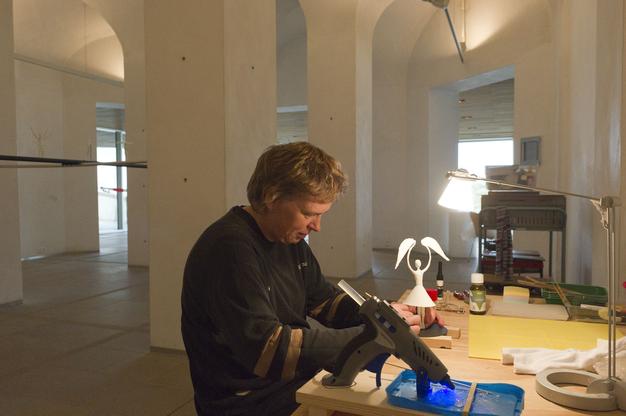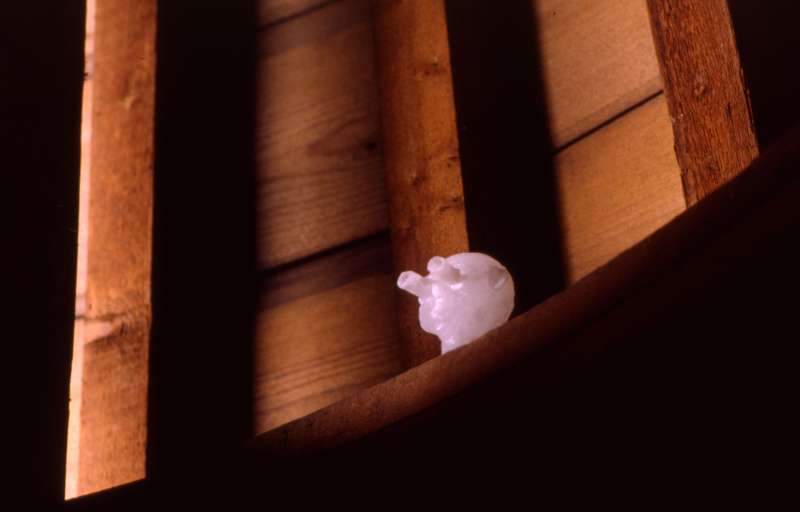
Still: An Installation by Anne-Marie van Sprang
Museum Beelden Aan Zee
17-9-2010 / 13-2-2011
On Sculptures Small
Miniature objects have a fascination that Few people can resist. There are model villages everywhere that attract visitors in droves. Around the world there must be millions of people who collect Dinky toys, model trains and doll’s houses. Miniature replicas of large objects are attractive to young and old, as toys and as objects of contemplation or fantasy. But the miniature world is not only a source of carefree pleasure. It can also provoke astonishment or confusion, or be disturbing, particularly when tiny living creatures are involved. Folk stories are teeming with dwarves, fairies and elves. Literature is full of characters, such as Gulliver or Alice, who are enormous or suddenly become so and therefore see their environment shrink to doll’s house format, or are so small that they are almost invisible in the normal world of humans.
Such tiny creatures seem to possess the ability to penetrate our psyche and awaken desires and fears that are hidden there. They belong to the realm of Das Unheimliche (The Uncanny), which Freud described in his essay of that title. This is a special subcategory of the fearful that leads us back to things that were once familiar and trusted, but which we have suppressed. In 1993 the Californian artist Mike Kelley curated a fascinating exhibition, based upon Freud’s ideas, entitled The Uncanny at the Museum voor Moderne Kunst in Arnhem, in which he combined art works with wax models, objects made of human or animal materials, automatons and bizarre objects. In the accompanying catalogue Kelley discussed the aberrant scale of objects and figures (extremely large or small) as an important contributing factor to the nature of the uncanny, although extremities of scale by no means always exercise an uncanny effect. In painting, for example, we perceive small figures as entirely normal as long as they fit within the governing perspective and proportion. In sculpture too there are legions of small human and animal figures. Throughout the centuries, life-size or larger-than-life-size figures have been made for places of worship and other public buildings, but there has also been a large private market for figurines.
We think nothing strange of encountering a small nude in bronze, stone or wood on someone’s windowsill or in a museum vitrine. There has to be something more going on in such a small sculpted figure to bring about the psychological effect pointed to by Freud and Kelley, or in a milder form, to provoke surprise or confusion. That ‘more’ might be constituted by the particular fashion in which the sculptor treats the relationship between the small figure and its surroundings: not leaving it to chance, but seeing it as a component of his artistic strategy. Giacometti was a master in this respect. In the late1930s, following his Surrealist period, he felt the need to return to modeling from life. He began at a relatively conventional scale, but increasingly arrived at figures that were barely larger than a matchstick. These miniature nudes, cast in bronze, stand on modelled and cast bronze cube shaped bases, which are extremely large in proportion to the figures: they form a sort of plaza or building, which is nonetheless entirely dominated by the tiny figure at its centre. In his later sculptures too the design of the bases and plateaus on which the figures stand is of great importance to the spatial effect of the whole: they both delineate a certain area and ensure that this remains in an open connection to the environment in which the sculpture is displayed. This is especially true of the cage-like constructions in which he occasionally imprisoned his small figures. But even when he abandoned this device and displayed his large sculptures in a gallery or square without a base, albeit on large feet, they exercise an enormous hold on the environment.
The expressiveness of Giacometti’s work resides, therefore, not only in the figures themselves, but also in an immaterial component in the interplay between the sculpture and the surrounding space. We see a similar approach in much recent sculpture, even in abstract sculpture. For example, from the early 1970s the American sculptor Joel Shapiro made extremely small sculptures (mostly from beam-like geometric metal elements, which were initially abstract but later formed schematic human figures) that he placed directly on the floor at huge intervals, sometimes siting only a single work in each large gallery space. Since that time sculpture has increasingly taken the route of installation art, in which the objects and the available space enter into an intimate relationship.

This expansion of sculpture is also manifest in the work of Anne-Marie van Sprang. For almost twenty-five years she has made minuscule sculptures, sometimes in bronze or glass, but mostly in fragile materials such as beeswax, paraffin and porcelain, which she preferably exhibits in a display tailored to a specific space and situation. Even within group exhibitions with numerous participants, she confidently manages to create her own domain.
Fine examples of this practice were the installations she made as part of the three yearly series of Utrecht Salons organised by the Centraal Museum at various locations since the early 1990s. In 1995 the exhibition was held in the museum itself. Van Sprang chose the top of the round tower above the stairwell for her work, accessible only by a narrow wooden staircase. When the visitor stuck his head through the floor, he saw several white paraffin sculptures loom up in the semidarkness, standing, hanging or lying between the wooden beams. Most were no more than six or ten centimeters high. It was an enchanting experience, like the memory of a beautiful childhood peep show.

Of a similar order was the presentation a year later of a group of works in porcelain made at the European Ceramic Workcentre in Den Bosch. The extremely Fragile miniatures – a house, a boat, a book and a half-length human figure –were placed at large intervals in a pool of water the floor, reflected in its dark surface.
In 1998 the Utrecht Salon was held in Utrecht’s old City Hall, whose interior had been stripped awaiting refurbishment. In a former lavatory – actually no more than a small corridor, which could be viewed only from the door opening –Van Sprang covered the floor with puddles of congealed paraffin on which she placed miniscule animal figures in the same material. It was as if a dream landscape had descended into the bare reality of the everyday.
This latter installation existed only for the duration of the exhibition, after which it was destroyed. The same is true of Van Sprang’s solo exhibition at "De Fabriek" in Eindhoven in1993, which lasted only a single night. Scattered across the floor of the industrial building were small paraffin sculptures, each containing a wick. During the night the small objects burned down – providing the only light source in the space – and the exhibition ended as the last flame died away. I know this installation only from photographs, but it must have been an extraordinarily beautiful sight, an arresting representation of transience. Van Sprang usually composes her installations from sculptures that are intended to live a life of their own outside that context.
This is also the case with the promising work that she has conceived for Museum Beelden aan Zee: a procession of nineteen small figures in various poses and with all manner of wonderful accessories, mounted on a twelve-meter long plank that seems to float in the space at eye level.
Once her sculptures have entered a museum or a private collection, she has no more say in how they are presented. But if the museum curator or collector is not too insensitive and does not crowd the sculptures, as sometimes happens with traditional figurines, but gives them space, then they cannot fail to have their intended effect. In a certain sense the sculptures themselves dictate the territory they require, they create their own space despite their small format. That is their great quality.
Carel Blotkamp,
Professor Emeritus of the history of modern art at the vu University, Amsterdam
Translation Dutch/ English: Gerard Frode